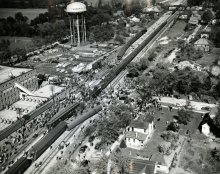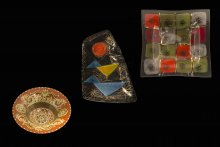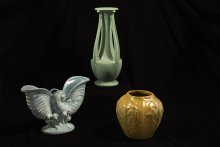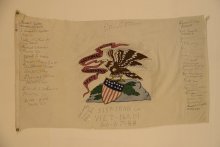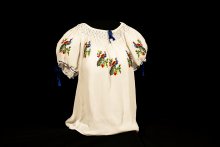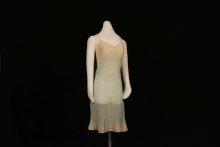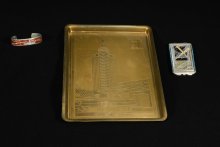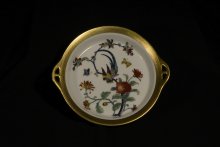Modern Era (1917-present)
The state’s Modern Era has been one of continued growth and change. Following World War I and the nation’s greatest economic collapse, public works projects of the New Deal put people to work on civic projects, such as building roads and infrastructure, and brought history to life by protecting a number of historic places around the state. The Federal Arts Program of the W.P.A. paid artists to create paintings, prints, sculptures, and murals for civic beautification, pride, and capturing the moment. Beginning in 1941, the state’s agricultural and manufacturing sectors and the sacrifices of citizen-soldiers played an important role in making the United States a leader on the world stage.
On April 25, 1946, the Chicago, Burlington, and Quincy Railroad’s high-speed passenger train, the Exposition Flyer, rammed into the Advance Flyer in Naperville, Illinois. Forty-five people died, and 125 people were injured in the collision. Naperville residents, like the employees of Kroehler Furniture Factory and students from North Central College, volunteered to help the injured, while emergency workers traveled from neighboring communities to assist in recovery efforts.
Illinois-based Kroehler Manufacturing Company was one of the largest upholstered furniture manufacturers in the world for 80 years. It had major influence on the buying habits of the American public. The Naperville company sponsored a traveling exhibit of twelve miniature rooms, “Four Generations of Furniture Fashion.” Commissioned by Kroehler and E.I. DuPont de Nemours in the mid 1960s, the exhibit traveled widely through the late 1970s to stores and shopping centers that carried Kroehler furniture.
In the 1930s, Illinois fast food entrepreneurs Earl Prince and Walter Fredenhagen found that existing soda fountain machines were not up to the task of mixing their Prince Castle “One in a Million” malted milkshakes. A heavy-duty, centrally-mounted, motor-driven, individual mixing shaft solved the problem, and the Multimixer was born.
Glass artists Frances and Michael Higgins met at the Chicago Institute for Design and married in 1948. Together, they founded The Higgins Studio in their Chicago apartment, using kilns positioned behind their sofa to create decorative and everyday items using their signature fused glass technique. They quickly attracted orders from major retailers such as Marshall Field’s and Georg Jensen.
Illinois’ tradition of art pottery can be traced back to the Great Chicago Fire of 1871. In the wake of this tragedy, the need for economical, fireproof building materials was made clear, and the architectural terra cotta industry was born. At the same time, the Arts and Crafts movement inspired ceramists to combine artistry with industry to create pottery whose beauty lay not in hand-applied surface decoration but in innovative shapes.
This flag was flown over the tents and barracks of the 515th Transportation Company at Cam Rahn Bay from 1966-68 during the Vietnam War. It is signed by the 22 Illinois members of that company. The 515th, known as the Roadrunners, drove 5-ton trucks hauling supplies to the troops in 12 hour shifts around the clock, 365 days each year.
Estanislao Goff purchased this blouse on a trip to Mexico in the late 1940s. That trip was the last time she would ever see her homeland, and the blouse was a reminder of the country and culture she had left behind decades earlier.
First Lieutenant Irwin Davenport bought this nightgown for his young bride, Beatrice, in Paris at the end of World War II. Beatrice and Irwin were college sweethearts who had married on June 15, 1943.
During the depths of the Great Depression in 1933-34, Chicago staged its second world fair, A Century of Progress International Exposition, to celebrate its centennial anniversary. Its purpose was to celebrate the amazing advances in technology during the period 1833-1933 and to inspire fairgoers with the promise of the happier future that scientific innovation promised.
This bowl was painted with a bird of paradise design by Swedish immigrant Ingeborg Klein for the Pickard China Company. Klein worked for Pickard from 1920 until about 1925, when she returned to Sweden.
Pages






